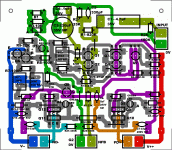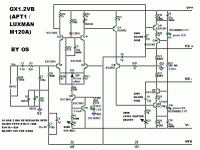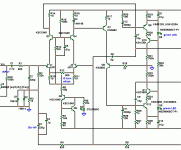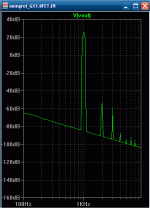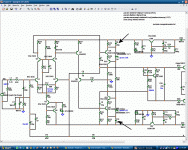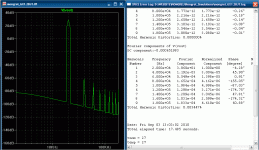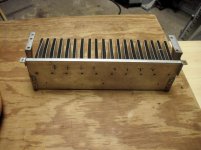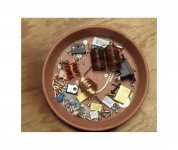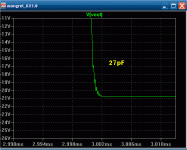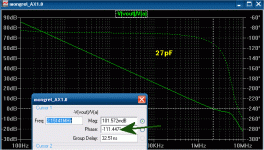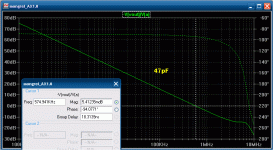Class A amps would be really useful for schools, where the air conditioners never work right, and the classrooms are always freezing in summer and scorching in winter (true story!). Although it wouldn't fix the winter part, I know I'd be a hero if I got a variable bias "heater" in each room...
46db@100KHz is possible for a headamp at 80 degrees phase margin, but I wouldn't expect the same to be possible for a power amp. Your sim shows ~20 degrees phase margin. Despite that, if a Zobel is enough to keep it stable, signs seem to indicate that higher open-loop BW, correlates with sound quality. I see this type of compensation on a lot of popular amps.
- keantoken
46db@100KHz is possible for a headamp at 80 degrees phase margin, but I wouldn't expect the same to be possible for a power amp. Your sim shows ~20 degrees phase margin. Despite that, if a Zobel is enough to keep it stable, signs seem to indicate that higher open-loop BW, correlates with sound quality. I see this type of compensation on a lot of popular amps.
- keantoken
Last edited:
The GX(apt1/luxman-M120a) . is finally done.  It is at the root of the mongrel website as "GX1.2VB_complete.zip". I still have to finish the "top mirror" , but one could make a working circuit as is.
It is at the root of the mongrel website as "GX1.2VB_complete.zip". I still have to finish the "top mirror" , but one could make a working circuit as is.
The layout is immaculate (attachment1), the circuit exists in the world several hundred thousand strong (most luxman class AB products). My version is cooler .. you can use almost any TO-126 VAS driver (Q9 and 12) , and use almost any input pair considering the 15V cascode voltage reference for the LTP and just 2.1V for either VAS device. I have tried the j201 FET , ksc1845, BC547C ... anything..
.. you can use almost any TO-126 VAS driver (Q9 and 12) , and use almost any input pair considering the 15V cascode voltage reference for the LTP and just 2.1V for either VAS device. I have tried the j201 FET , ksc1845, BC547C ... anything..  the amps specs change very little... A SUPER forgiving circuit.
the amps specs change very little... A SUPER forgiving circuit.  Also , the 2 magic resistors (R20 and 24) are supposed to minimize "memory distortion". If you don't like them, jumper them.
Also , the 2 magic resistors (R20 and 24) are supposed to minimize "memory distortion". If you don't like them, jumper them.
One might ask WHY are there 3 trimmers onboard ?? The one (attachment 2 -R27 "LS adj.) compensates for the unavoidable imbalance between P and N channel devices which can not be avoided with modern semiconductors. Distortion falls by a small margin so this is worth another 2$ part cost.
The one (attachment 2 -R27 "LS adj.) compensates for the unavoidable imbalance between P and N channel devices which can not be avoided with modern semiconductors. Distortion falls by a small margin so this is worth another 2$ part cost. The constant current adjust is INVALUABLE , you can set the VAS average current , use FET's or BJT's (attachment 3 - FET) and set a range for the Vbe on the power board ... Definitely worth another 2$. The "offset" is self explanatory as even when I built the "supersym" and tried to match the input pairs with my DMM , I ended up with 10mV offset (OH NO), I like 1 or less.
The constant current adjust is INVALUABLE , you can set the VAS average current , use FET's or BJT's (attachment 3 - FET) and set a range for the Vbe on the power board ... Definitely worth another 2$. The "offset" is self explanatory as even when I built the "supersym" and tried to match the input pairs with my DMM , I ended up with 10mV offset (OH NO), I like 1 or less.
If I was richer I would build a tube amp as to watch the blue glow of the rectifier tubes
 . Being "POH" , I have to use LED's to "get off". D3 ,4, and 5 are both the confirmation of the CCS and VAS cascode operation and D4/5 set the 2.1 to 2.4 volt VAS cascode voltage references. These are the most critical points for this amps operation ,so it is nice to confirm their proper function. On the VAS ,with Q9 and 12, I have tried MJE340/350, (yuk!!
. Being "POH" , I have to use LED's to "get off". D3 ,4, and 5 are both the confirmation of the CCS and VAS cascode operation and D4/5 set the 2.1 to 2.4 volt VAS cascode voltage references. These are the most critical points for this amps operation ,so it is nice to confirm their proper function. On the VAS ,with Q9 and 12, I have tried MJE340/350, (yuk!!  ) BCxxx,2sa1220/2sc2690 , and many others. This just slightly affects total loop gain but does not destabilize the whole amp in any way. 33, 47, or 56pF for the two Cdom's (C7 and C9)will work, while in the alternative compensation, (attachment 3) 10pF is advised . 33p is the best for slewing and a unity gain point of 600khz. I did include the extra pads for the ORIGINAL luxman two pole compensation "TPC" (C11-12 / R29-30 in attachment 3).
) BCxxx,2sa1220/2sc2690 , and many others. This just slightly affects total loop gain but does not destabilize the whole amp in any way. 33, 47, or 56pF for the two Cdom's (C7 and C9)will work, while in the alternative compensation, (attachment 3) 10pF is advised . 33p is the best for slewing and a unity gain point of 600khz. I did include the extra pads for the ORIGINAL luxman two pole compensation "TPC" (C11-12 / R29-30 in attachment 3).
Finally the real reason why this amp was used so exclusively by luxman and the APT1 .... the FFT (with the FET's,attachment 4) shows VERY low high order harmonics with a dominant 2'nd . With the Bjt's everthing is 6dB lower. What we have is an amp that is easy to build with many part choices and adjustment options , runs VERY cool using 16mA per rail and can be built EXACTLY as the LUXMAN M120a .. they still make 2sa970/2sc2240. Who can beat a 600$ amp "core" for under 40$ ??
. With the Bjt's everthing is 6dB lower. What we have is an amp that is easy to build with many part choices and adjustment options , runs VERY cool using 16mA per rail and can be built EXACTLY as the LUXMAN M120a .. they still make 2sa970/2sc2240. Who can beat a 600$ amp "core" for under 40$ ??
My subjective opinion on this amp after reading hundreds of reviews , seeing it work with the "frugal APT" and simulating it , is that even as it has higher distortion than a blameless or a symasym , it's real test will be controlling a reactive speaker load that distorts at 1-5%THD .. whether it has .0001 or .03% THD matters not as it will be swamped out by the real world anyways. This goes for the addition of the FET's as they double the THD but enhance the character of the input stage.
PS .. other "features" , large "audiophool" input cap capability(20 X25mm) ,full "face to face" thermal coupling of cascodes/VAS , LTP , detailed layout (each trace is very well thought out ,in the head.. no machine ) and oversized pads for bad solderers...
) and oversized pads for bad solderers...
End of diatribe... (love that word)
OS
The layout is immaculate (attachment1), the circuit exists in the world several hundred thousand strong (most luxman class AB products). My version is cooler
One might ask WHY are there 3 trimmers onboard ??
If I was richer I would build a tube amp as to watch the blue glow of the rectifier tubes
Finally the real reason why this amp was used so exclusively by luxman and the APT1 .... the FFT (with the FET's,attachment 4) shows VERY low high order harmonics with a dominant 2'nd
My subjective opinion on this amp after reading hundreds of reviews , seeing it work with the "frugal APT" and simulating it , is that even as it has higher distortion than a blameless or a symasym , it's real test will be controlling a reactive speaker load that distorts at 1-5%THD .. whether it has .0001 or .03% THD matters not as it will be swamped out by the real world anyways. This goes for the addition of the FET's as they double the THD but enhance the character of the input stage.
PS .. other "features" , large "audiophool" input cap capability(20 X25mm) ,full "face to face" thermal coupling of cascodes/VAS , LTP , detailed layout (each trace is very well thought out ,in the head.. no machine
End of diatribe... (love that word)
OS
Attachments
I am about to "go down the rabbit hole". Mouser is shipping me the "fab in a box" toner transfer materials.. along with the parts for a lots of amps. They are fast, monday or tuesday , next week. 
mouser toner transfer papers
This stuff is "bomb" ,the white foil can turn HP toner white.. the green foil seals the etch resist layer on the copper side. Independent of the company's "shilling", I have seen what this material can do (youtube). It can go down under a mil , so my "big stuff" should be excellent.
You will see 2 PB250's be "born" , tested and tweaked. I will build 2 GX1.2's , 2 AX1.1's , 2 BX1.1's and 2 PB60's. If all works out I will have the 60's to trade or sell and most of the proven amps (AX,BX) to go with them.
On MY amps (the GX's) , at least in simulation (below) , you just change C8 and C10 to .68 -1uF and it holds .003-4%THD all the way from 1k to 35Khz ..any power level all the way to clipping. Luxman and APT chose well !
BTW , when I get these done , I will give the remnants of my "supersym's" minus 2 pairs of outputs,the emitter resistors and my brand new 4700uF filter caps (still a lot of parts and fully working-13 months) to Keentoken as promised. he might have to spring for 8- .22R/5w units..
OS
mouser toner transfer papers
This stuff is "bomb" ,the white foil can turn HP toner white.. the green foil seals the etch resist layer on the copper side. Independent of the company's "shilling", I have seen what this material can do (youtube). It can go down under a mil , so my "big stuff" should be excellent.
You will see 2 PB250's be "born" , tested and tweaked. I will build 2 GX1.2's , 2 AX1.1's , 2 BX1.1's and 2 PB60's. If all works out I will have the 60's to trade or sell and most of the proven amps (AX,BX) to go with them.
On MY amps (the GX's) , at least in simulation (below) , you just change C8 and C10 to .68 -1uF and it holds .003-4%THD all the way from 1k to 35Khz ..any power level all the way to clipping. Luxman and APT chose well !
BTW , when I get these done , I will give the remnants of my "supersym's" minus 2 pairs of outputs,the emitter resistors and my brand new 4700uF filter caps (still a lot of parts and fully working-13 months) to Keentoken as promised. he might have to spring for 8- .22R/5w units..
OS
Attachments
Good work, OS...
So far, the sims i made show some of your amps
being first class compared to many designs that
are running by there...
I will open a thread comparing the production
of the designers that publish at DIY audio..
Your AX and SPSYM will be in the lot...
thanks , Wahab...
I really am surprised by the GX , I'm sure DX will be a "clonin' " this one soon.
the cascodes seem to not only have a theoretical effect on the amp (early effect and VAS impedance) ..but low THD out into the ultrasonics . Reading the "sparkling" reviews of both the APT and Luxman ,this also gives a VERY good sound.
OS
Last edited:
Ostripper, be careful about changing the original compensation (concerning the Luxman/APT amps). Adjusting the compensation for my headamp makes the difference between great and mediocre sound quality - I discovered this just in the last several days. How much have you experimented with compensation on real boards?
- keantoken
- keantoken
Ostripper, be careful about changing the original compensation (concerning the Luxman/APT amps). Adjusting the compensation for my headamp makes the difference between great and mediocre sound quality - I discovered this just in the last several days. How much have you experimented with compensation on real boards?
- keantoken
I deeply considered this and have the pads for both the luxman and basic APT1 compensation on the prototype Voltage stages (GX1.2). Monday or tuesday, (Texas to here from mouser is VERY fast) I will know. I am going to show the forum the WHOLE process (boards , construction , and testing/abuse)
I have really "farted around" with the "supersym" compensation , it has a drastic effect on the final sound. Yet another reason for the sensibility of the modular approach.
BTW , I saw your workstation in the headamp thread ... cool ,you have what you need for great things (developments, general mayhem)!! I just got my Oscope and and a new DMM.
OS
Last edited:
I am going to show the forum the WHOLE process (boards , construction , and testing/abuse).
Sounds exciting! I will be watching.
- keantoken
Sounds exciting! I will be watching.
- keantoken
dang holiday slowed it down(mouser order).... I want to build 4 amps !! ...
below)..
I did scrap a test heatsink to fire up the power boards with 1 pair OP's, found magnet wire for my inductors and to-220 hardware for driver mounting in some old PC power supplies
OS
Attachments
Last edited:
Os the Gx looks good, the Luxman should perform better than the apt, there is quite a difference between them, maybe not obvious at first sight and the reason its good upto high frequencies. The Luxman has so called hawksford cascodes while the apt uses conventional cascodes, the hawksford being superior by quite a margin although there could be stability issues.
This type cascode was named after hawksford after his paper regarding slope distortion back in 1987 I think it was, but in actual fact the oldest reference I can find using this setup is Luxman, they predate hawksford by about 7 years. Nowadays many high end manufacturers use it. My hats off to Luxman, I have studied their amps a few years back, they are excellent, they were far in advance technically to anything else on the market 30 years ago. Look at their folded cascode designs, excellent executions done 30 years ago.
This type cascode was named after hawksford after his paper regarding slope distortion back in 1987 I think it was, but in actual fact the oldest reference I can find using this setup is Luxman, they predate hawksford by about 7 years. Nowadays many high end manufacturers use it. My hats off to Luxman, I have studied their amps a few years back, they are excellent, they were far in advance technically to anything else on the market 30 years ago. Look at their folded cascode designs, excellent executions done 30 years ago.
Os the Gx looks good, the Luxman should perform better than the apt, there is quite a difference between them, maybe not obvious at first sight and the reason its good upto high frequencies. The Luxman has so called hawksford cascodes while the apt uses conventional cascodes, the hawksford being superior by quite a margin although there could be stability issues.
This type cascode was named after hawksford after his paper regarding slope distortion back in 1987 I think it was, but in actual fact the oldest reference I can find using this setup is Luxman, they predate hawksford by about 7 years. Nowadays many high end manufacturers use it. My hats off to Luxman, I have studied their amps a few years back, they are excellent, they were far in advance technically to anything else on the market 30 years ago. Look at their folded cascode designs, excellent executions done 30 years ago.
So THAT is the famous "hawksford" cascode. I heard it mentioned but never saw it in practice before the luxman. With either the FET's or BJT inputs it blows the APT away. I did try both cascodes until I noticed the hawkford's better performance over a much wider range. This is the first one I will build and audition over the next few days , but by what I see , I should be VERY pleased.
Thanks for identifying this for me. You seem to be a amp historian..
OS
Ostripper, be careful about changing the original compensation (concerning the Luxman/APT amps). Adjusting the compensation for my headamp makes the difference between great and mediocre sound quality - I discovered this just in the last several days. How much have you experimented with compensation on real boards?
- keantoken
Kean and OS, generally towards which end of the continuum does compensation sound good; just a little above under-compensation or more towards over-compensation? In an amp I am testing right now, the Cdom in a cascoded VAS comprising of 2SA970 and 2SA1538 is 48pf. It sounds quite good. However, I want to try 27.4pf, 32pf (22 + 10), 39.4 (27.4 + 12), 44pf (22 + 22), 58.4pf (48.4 + 10), 60.4pf (48.4 + 12) and 70.4pf (48.4 + 22). Now that is a lot of values with just 5 values of Silver Mica caps which I have at hand (ie., 10, 12, 22, 27.4 & 48pf). Once the best 'sonic' value is determined, I plan to order for the nearest value polypropylene cap available. Silver Micas are now unobtanium where I live. Listening tests may be very hard to judge as to the best sonics. Hence, a pointer will be deeply appreciated. Thanks.
Kean and OS, generally towards which end of the continuum does compensation sound good; just a little above under-compensation or more towards over-compensation? In an amp I am testing right now, the Cdom in a cascoded VAS comprising of 2SA970 and 2SA1538 is 48pf. It sounds quite good. However, I want to try 27.4pf, 32pf (22 + 10), 39.4 (27.4 + 12), 44pf (22 + 22), 58.4pf (48.4 + 10), 60.4pf (48.4 + 12) and 70.4pf (48.4 + 22). Now that is a lot of values with just 5 values of Silver Mica caps which I have at hand (ie., 10, 12, 22, 27.4 & 48pf). Once the best 'sonic' value is determined, I plan to order for the nearest value polypropylene cap available. Silver Micas are now unobtanium where I live. Listening tests may be very hard to judge as to the best sonics. Hence, a pointer will be deeply appreciated. Thanks.
It is not just the cap , sam. As a example one could use a 47pF on amp "A" with 47R degeneration on the LTP. On amp "B" with 22R degeneration on the LTP , a 68pF compensation cap will give the same loop gain response. the 3'rd leg of the "stool" (chair) is the degeneration of the VAS.
what I say is that you can get the loop response of any "inbetween value" by careful selection of the other two factors as explained above.
OS
I just want to warn you Sam , swapping cdom on a power amp can destroy the amp.
To find the lowest stable value , which for the AX (blameless) is 27pF, look at the squarewave response in attachment 1. That slight ringing without a capacitive load (8R resistive load only) shows under compensation. This corresponds to plot 2 which shows a -111.4 degrees phase. this leaves only a 68 degree margin (75-85 is best and stable). I could of predicted plot 1 just by seeing plot 2. To be on the safe side I chose 47pF instead of 27pF for 3 reasons:
A. better to be a little overcompensated than not , you may have a slightly slower amp .. but a safe one.
B. 47p brings the unity gain point to 575khz and phase to -94 deg. giving 86deg. margin ..(attachment 3), this amp will drive even a 22uF cap with just highly damped ringing.
C. larger Cdom allows you to lessen degeneration of input pair and VAS increasing loop gain.
I would not do this swap on a real amp without at least seeing the "bottom range" using the simulator. I have never had a warm zobel network or a fatal outbreak of uncontrolled oscillation to date.
OS
To find the lowest stable value , which for the AX (blameless) is 27pF, look at the squarewave response in attachment 1. That slight ringing without a capacitive load (8R resistive load only) shows under compensation. This corresponds to plot 2 which shows a -111.4 degrees phase. this leaves only a 68 degree margin (75-85 is best and stable). I could of predicted plot 1 just by seeing plot 2. To be on the safe side I chose 47pF instead of 27pF for 3 reasons:
A. better to be a little overcompensated than not , you may have a slightly slower amp .. but a safe one.
B. 47p brings the unity gain point to 575khz and phase to -94 deg. giving 86deg. margin ..(attachment 3), this amp will drive even a 22uF cap with just highly damped ringing.
C. larger Cdom allows you to lessen degeneration of input pair and VAS increasing loop gain.
I would not do this swap on a real amp without at least seeing the "bottom range" using the simulator. I have never had a warm zobel network or a fatal outbreak of uncontrolled oscillation to date.
OS
Attachments
Last edited:
Thanks OS and Kean. I use a rather old simulator - Electronics Work Bench 5.0. The models are not upto the mark and the library limited. However, with this I simulated that the amp I referred to was unstable with 22pf Cdom and stable from 27pf upward. The LTP degeneration is 22 ohms.
I was playing one channel of the amp before this post and after about an hour found the Zobel ever so slightly warm. The speed of the amp with 48pf Cdom is really good. But maybe, I'll try some upper values and won't risk any value lower than 48pf.
I understand how Cdom affects stablility. But I was asking whether going towards under-compensation sounds good or going towards over-compensation?
It is high time, I started learning LT Spice.
I was playing one channel of the amp before this post and after about an hour found the Zobel ever so slightly warm. The speed of the amp with 48pf Cdom is really good. But maybe, I'll try some upper values and won't risk any value lower than 48pf.
I understand how Cdom affects stablility. But I was asking whether going towards under-compensation sounds good or going towards over-compensation?
It is high time, I started learning LT Spice.
Last edited:
Sam,
You are undercompensated, just as OS indicates. Try adding some degeneration, 10R, on the VAS.
A square wave CRO test is best, again as Pete suggests, but you can also tell when it's undercompensated from a very bright, splashy sound and a warm Zobel resistor. Sibilance is very bad on voices with the S phoneme. Trimming compensation with VAS degeneration is a very good way to do it, within reason, as the resulting increased output impedance of the VAS may increase distortion levels driving the output stage, so keep it under 47R. Start with a 10R resistor. As you overcompensate, treble drops off abruptly and the sound grows leaden and lifeless.
Silver mica is definitely the best cap to use. Does not Saha, the large Indian maker of SM caps, sell locally?
Hugh
You are undercompensated, just as OS indicates. Try adding some degeneration, 10R, on the VAS.
A square wave CRO test is best, again as Pete suggests, but you can also tell when it's undercompensated from a very bright, splashy sound and a warm Zobel resistor. Sibilance is very bad on voices with the S phoneme. Trimming compensation with VAS degeneration is a very good way to do it, within reason, as the resulting increased output impedance of the VAS may increase distortion levels driving the output stage, so keep it under 47R. Start with a 10R resistor. As you overcompensate, treble drops off abruptly and the sound grows leaden and lifeless.
Silver mica is definitely the best cap to use. Does not Saha, the large Indian maker of SM caps, sell locally?
Hugh
- Status
- This old topic is closed. If you want to reopen this topic, contact a moderator using the "Report Post" button.
- Home
- Amplifiers
- Solid State
- The MONGREL (supersym II)
